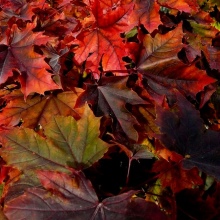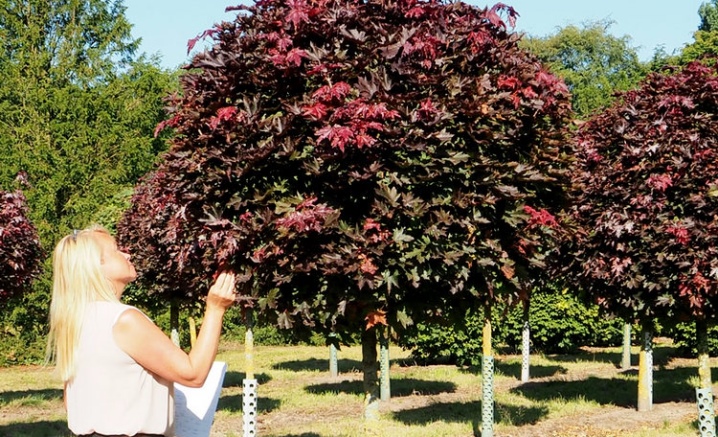Norway maple "Crimson Sentry"

Maple has many species, of which holly is considered the most common. Unlike other varieties, it can be found not only in the mountains, but also in flat areas. This tree has many varieties, one of which is "Crimson Sentry". The latter is considered a decorative representative of the flora, therefore it is often used to decorate the territory.

Description
Norway maple "Crimson Sentry" is represented by a slender tree with a high crown density. The branches of the plant are directed upward, and purple leaves adorn it all year round. The branches of the culture are characterized by a short length, density, they grow from the lowest part of the trunk. Often you can find specimens that are grafted on a trunk, it is on this that the characteristics of the maple depend.


At the Crimson Sentry high decorative qualities, since its young leaves are colored red with a reddish tint. Ripe leaves have five lobes and a dark red color, glossy surface. In autumn, the tree has a crimson foliage. The variety is characterized by a narrow, dense, columnar crown. Usually its height reaches 8-10 meters, and its diameter is 3-4 meters.
Culture refers to slow growing... During the period of yellow-green flowering, you can see brushes in the form of umbrellas on the crown. The Norway maple looks very beautiful during flowering. The fruits of this representative of the flora are horizontally located lionfish. Crimson Sentry has a taproot system and a large number of thin roots located in the upper soil layer.

This variety of Norway maple is used for landscaping the following areas:
- housing complexes;
- territories of hospitals;
- educational institutions;
- private territories;
- summer cottages;
- streets and boulevards;
- squares, parks, recreation areas.
This plant can be planted singly or in groups. In the autumn season, maple pleases with a riot of colors and shapes. In the summer, he is able to decorate the site thanks to his juicy openwork leaves.



Landing
It is best to plant the Norway maple outdoors in the first weeks of spring or in the fall. When choosing a site, it is worth considering that the distance between the seedlings of this culture should be 250-300 cm. The best choice would be a lighted or shaded place with a well-drained substrate. The depth of the hole should correspond to the size of the root ball of the seedling, and the width should be 4 times larger than it.

If a close passage of groundwater is noticed in the territory, then in this case the depth of the hole can be increased, since its bottom will need to be laid with a drainage layer of 15 cm.In order for the roots of a young maple not to dry out, they are placed in water for a couple of hours. When the pit is prepared, 120 grams of nitroammofoska is poured into it, after which the plant is lowered and the root system is carefully straightened. A nutrient mixture is poured on top, which contains humus, sand, sod soil in a ratio of 3: 1: 2.


At the end of the planting process, the root collar of the maple should be a couple of centimeters above ground level. The newly planted crop must be watered with 30 liters of water. When the water is absorbed, you will need to mulch the seedling's trunk circle.
Care
The grafted "Crimson Sentry" in the first days after planting should be well watered... When the tree becomes strong and mature, irrigation should not be stopped.In spring and autumn, the procedure is carried out once a month, and in summer - once a week. 40 liters of water should be enough for a young representative of the flora at a time, and 20 liters less for an adult. After irrigating the maple, you need to start loosening its near-trunk circle, as well as removing weeds.

If all the necessary fertilizing was introduced into the planting hole at the time of planting, then for a whole year the plant will not have to be fertilized. In the spring, rotted manure is introduced into the near-trunk circle of the Norway maple. Pills that slowly release nutrients have also proven themselves well. The Crimson Sentry is not fed in the fall.
The dormant period of culture can be called the time from the beginning of the first frost to the first spring month. A young tree will need shelter for the winter, in this case burlap is fixed on the trunk and fixed with a rope. Thanks to this procedure, the plant will be protected not only from severe frost, but also from rodents.

Crimson Sentry needs sanitary pruning. In the course of such work, it is worth removing frozen, broken, deformed branches. In addition, do not forget about cutting out the root growth.
It is also recommended to cut off the stems that grow into the crown or stick out in all directions.
Reproduction
Norway maple can be propagated in three ways.
- Seeds... With the help of seed material "Crimson Sentry" reproduces quite simply. For this, the seeds are sown in the autumn in the beds so that they undergo natural stratification. In the springtime, gardeners will already have the opportunity to see seedlings and plant them.

- Air layering. To carry out reproduction on the selected branch, the bark is cut several times, after which it is treated with "Kornevin". It is necessary to insert particles of foam plastic into the cuts, cover them with moistened moss and attach plastic bags nearby. After that, foil is applied to the twig. After a while, roots immersed in sphagnum will begin to appear at the points of the incisions. Next spring, during the period of active growth, the layers will need to be separated from the plant, foil and polyethylene and planted in the ground in conjunction with moss.


- Root layering. Initially, the gardener will need to make cuts on the roots of the plant, after which they will be treated with a special solution. The next steps in maple propagation are high hilling, covering the cuts with a substrate. Throughout the season, the layers will need to be irrigated and hilled. By next season, the Crimson Sentry will have young roots that can be dug up and planted on a new site.

Diseases and pests
Like any other representative of the flora, "Crimson Sentry" can suffer from infectious diseases and parasites. When the tree dries up, the leaves turn green and the stems droop, it looks weak and lags behind in growth, then the gardener should think about treating the culture. Quite often, Norway maple is attacked by coral spot. This ailment manifests itself in the dying off of branches, as well as the formation of small burgundy spots on the bark.

If a problem is found, you will need to immediately cut off the affected branches, and process the cuts with a garden varnish.
There are cases when "Crimson Sentry" interfere with the normal growth and development of a mealybug, leaf weevil. If a whitefly attacked a tree, then it can be destroyed by treating the tree with ammophos. You can get rid of mealybugs with Nitrafen, and weevils by spraying with Chlorophos. When working, the gardener should remember that the use of all of the above substances should be strictly according to the instructions.
For more information about the Crimson Sentry maple, see the video below.



































































The comment was sent successfully.